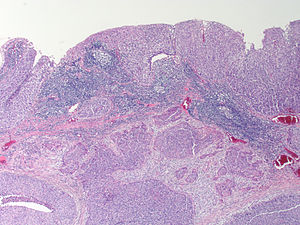Difference between revisions of "Anal squamous cell carcinoma"
Jump to navigation
Jump to search
| Line 1: | Line 1: | ||
{{ Infobox diagnosis | |||
| Name = {{PAGENAME}} | |||
| Image = Anus SquamousCellCarcinoma SCC NonKeratinizing AIA SCCIS CTR.jpg | |||
| Width = | |||
| Caption = Anal squamous cell carcinoma. [[H&E stain]]. | |||
| Synonyms = | |||
| Micro = | |||
| Subtypes = | |||
| LMDDx = | |||
| Stains = | |||
| IHC = | |||
| EM = | |||
| Molecular = | |||
| IF = | |||
| Gross = | |||
| Grossing = | |||
| Site = [[anus]] | |||
| Assdx = | |||
| Syndromes = | |||
| Clinicalhx = +/-men who have sex with men, +/-immunodeficiency or immunosuppression | |||
| Signs = | |||
| Symptoms = | |||
| Prevalence = most common anal cancer, overall uncommon | |||
| Bloodwork = | |||
| Rads = | |||
| Endoscopy = | |||
| Prognosis = | |||
| Other = | |||
| ClinDDx = | |||
| Tx = surgical excision | |||
}} | |||
'''Anal squamous cell carcinoma''' is the most common type of [[anal cancer]].<ref name=pmid25741135>{{Cite journal | last1 = Ghosn | first1 = M. | last2 = Kourie | first2 = HR. | last3 = Abdayem | first3 = P. | last4 = Antoun | first4 = J. | last5 = Nasr | first5 = D. | title = Anal cancer treatment: Current status and future perspectives. | journal = World J Gastroenterol | volume = 21 | issue = 8 | pages = 2294-2302 | month = Feb | year = 2015 | doi = 10.3748/wjg.v21.i8.2294 | PMID = 25741135 }}</ref> | '''Anal squamous cell carcinoma''' is the most common type of [[anal cancer]].<ref name=pmid25741135>{{Cite journal | last1 = Ghosn | first1 = M. | last2 = Kourie | first2 = HR. | last3 = Abdayem | first3 = P. | last4 = Antoun | first4 = J. | last5 = Nasr | first5 = D. | title = Anal cancer treatment: Current status and future perspectives. | journal = World J Gastroenterol | volume = 21 | issue = 8 | pages = 2294-2302 | month = Feb | year = 2015 | doi = 10.3748/wjg.v21.i8.2294 | PMID = 25741135 }}</ref> | ||
| Line 5: | Line 36: | ||
==General== | ==General== | ||
*Most common form of anal cancer.<ref name=pmid25741135/> | *Most common form of anal cancer.<ref name=pmid25741135/> | ||
*Overall anal cancer uncommon.<ref name=pmid25741135/> | |||
*Strong association with [[HPV]].<ref name=pmid23616200>{{Cite journal | last1 = Cornall | first1 = AM. | last2 = Roberts | first2 = JM. | last3 = Garland | first3 = SM. | last4 = Hillman | first4 = RJ. | last5 = Grulich | first5 = AE. | last6 = Tabrizi | first6 = SN. | title = Anal and perianal squamous carcinomas and high-grade intraepithelial lesions exclusively associated with "low-risk" HPV genotypes 6 and 11. | journal = Int J Cancer | volume = 133 | issue = 9 | pages = 2253-8 | month = Nov | year = 2013 | doi = 10.1002/ijc.28228 | PMID = 23616200 }}</ref> | *Strong association with [[HPV]].<ref name=pmid23616200>{{Cite journal | last1 = Cornall | first1 = AM. | last2 = Roberts | first2 = JM. | last3 = Garland | first3 = SM. | last4 = Hillman | first4 = RJ. | last5 = Grulich | first5 = AE. | last6 = Tabrizi | first6 = SN. | title = Anal and perianal squamous carcinomas and high-grade intraepithelial lesions exclusively associated with "low-risk" HPV genotypes 6 and 11. | journal = Int J Cancer | volume = 133 | issue = 9 | pages = 2253-8 | month = Nov | year = 2013 | doi = 10.1002/ijc.28228 | PMID = 23616200 }}</ref> | ||
Revision as of 18:07, 19 March 2015
| Anal squamous cell carcinoma | |
|---|---|
| Diagnosis in short | |
 Anal squamous cell carcinoma. H&E stain. | |
| Site | anus |
|
| |
| Clinical history | +/-men who have sex with men, +/-immunodeficiency or immunosuppression |
| Prevalence | most common anal cancer, overall uncommon |
| Treatment | surgical excision |
Anal squamous cell carcinoma is the most common type of anal cancer.[1]
It is also known as anal squamous carcinoma and squamous cell carcinoma of the anus.
General
- Most common form of anal cancer.[1]
- Overall anal cancer uncommon.[1]
- Strong association with HPV.[2]
Risk factors:[3]
- Men who have sex with men.
- Immunosuppressed.
- HIV infection.
Microscopic
Features:
DDx:
- Anal gland adenocarcinoma.
- Poorly differentiated rectal adenocarcinoma.
IHC
Sign out
RECTUM, DISTAL, BIOPSY: - INVASIVE SQUAMOUS CELL CARCINOMA.
See also
- Anus.
References
- ↑ 1.0 1.1 1.2 Ghosn, M.; Kourie, HR.; Abdayem, P.; Antoun, J.; Nasr, D. (Feb 2015). "Anal cancer treatment: Current status and future perspectives.". World J Gastroenterol 21 (8): 2294-2302. doi:10.3748/wjg.v21.i8.2294. PMID 25741135.
- ↑ Cornall, AM.; Roberts, JM.; Garland, SM.; Hillman, RJ.; Grulich, AE.; Tabrizi, SN. (Nov 2013). "Anal and perianal squamous carcinomas and high-grade intraepithelial lesions exclusively associated with "low-risk" HPV genotypes 6 and 11.". Int J Cancer 133 (9): 2253-8. doi:10.1002/ijc.28228. PMID 23616200.
- ↑ Kutlubay, Z.; Engin, B.; Zara, T.; Tüzün, Y.. "Anogenital malignancies and premalignancies: Facts and controversies.". Clin Dermatol 31 (4): 362-73. doi:10.1016/j.clindermatol.2013.01.003. PMID 23806153.
- ↑ 4.0 4.1 Gunia, S.; Koch, S.; May, M. (Feb 2013). "Is CDX2 immunostaining useful for delineating anorectal from penile/vulvar squamous cancer in the setting of squamous cell carcinoma with clinically unknown primary site presenting with histologically confirmed inguinal lymph node metastasis?". J Clin Pathol 66 (2): 109-12. doi:10.1136/jclinpath-2012-201138. PMID 23105122.


